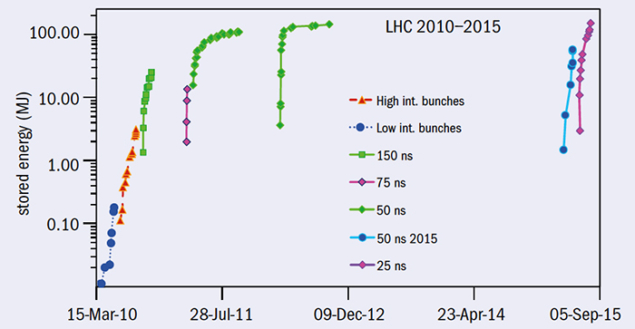
Thanks to the work done during the LHC machine-development period and technical stop at the end of the summer, the LHC is enjoying a stable-intensity ramp-up period, which is giving experiments precious data for their physics programmes.
During the machine-development break at the end of August, a variety of measurement and development programmes were carried out in the machine. They included tests for exploring the limits of smaller beam sizes at the interaction points and studies of collimation using bent crystals. Highlights also included the validation of a 40 cm β*, which effectively doubles the luminosity potential of the present set-up. Free from the challenges of high beam intensity, machine availability was high during this remarkably successful machine-development period.
This period was followed by a five-day technical stop. The key objectives were modifications to the critical Quench Protection System, the consolidation of the cooling and electrical-distribution systems, and important maintenance work on the cryogenics system. A huge number of activities were involved to make the technical stop a success.
The effort paid off: since the end of the technical stop, the LHC has gone smoothly through a complete validation period with beam, which ensures that the machine is ready for the intensity ramp-up from a machine-protection standpoint.
The validation is obtained step-by-step and with increasing intensity, both in terms of the number of bunches and the particles in each bunch. The first step consists of running through a full LHC cycle, from injection to collisions and beam dump. This is done initially with a low-intensity bunch (“probe”) to check all of the machine settings and equipment. This phase is followed by a series of collimation- and absorber-validation tests at different points in the LHC cycle. Low-intensity beams – typically the equivalent of three nominal bunches (3 × 1011 protons) – are expanded transversely or longitudinally, or are de-bunched to verify that the collimators and absorbers are correctly intercepting lost particles. The techniques for those validations have been improved progressively, and they can now be performed within 24 h in a few machine cycles.
As soon as the protection systems were validated with the probe beam, the intensity of the beam was ramped up in three steps to 459 bunches per beam – the level that had been reached before the summer stop. Further intensity ramp-ups are performed stepwise: at each step, the LHC must be operated for at least three periods of stable collisions. This is equivalent to integrating at least 20 h of operation before the next intensity step can be authorised. At each step, operators carefully analyse the data collected across many systems, in particular those related to machine protection, and give the green light for an intensity step only when all of the systems show satisfactory performance.
Following this scheme, about 10 days after the end of the break, the machine could be operated with around 1000 bunches per beam and 25 ns bunch spacing, which is the LHC design bunch spacing.
In the present beam configuration, the electron-cloud activity is still significant and considerable power is deposited onto the vacuum-chamber beam screen. For good performance of the machine, the beam-screen temperature should remain below 30 K, and this is achieved by managing the heat-load transients. This operation is particularly delicate for the cryogenic-system operation team in the CERN Control Centre during the injection and energy ramp-up of beams.
The beam intensity of Run 2 can also be measured in terms of the energy stored in each beam: with more than 1000 bunches per beam, the stored energy in each beam exceeds 100 MJ. Towards the end of September, the machine reached 150 MJ, breaking the record of Run 1 (140 MJ).








